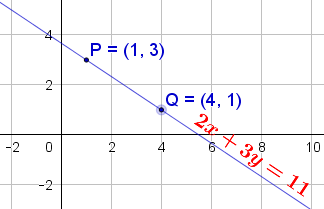Prior Lines Next
Lines and line equations are far easier and more general (as in “can exist in 3d”) using vectors. However, this section is an attempt to limit (but not exclude) the use of vectors in favor of a more traditional approach.
Equation of a 2d Line
We want to discuss a line on a single plane in 2 dimensional space, also called Euclidean space. Soon enough we will transition to multi-dimensions, but not now. In this space, the line can be defined as the shortest distance between two points. The points are tuples and vector coordinates as measured from an origin point, which will be assigned the coordinates $(0,0)$. Consider the line between points $P=(4,2)$ and $Q=(6,9)$. We will want to write the equation of the line between these points and will do so with a variety of methods.
General Linear Form
In algebra, a linear equation is one with constant coefficients for each of the coordinates (variables) and the coordinates must not be raised to any power nor combined by any operation other than add and subtract. Therefore, we could look for an equation of the form,$$ax+by+c=0\qquad\text{{linear}}$$ In dot product notation, $$\left(\begin{array}{c} a\\ b \end{array}\right)\cdot\left(\begin{array}{c} x\\ y \end{array}\right)+c=0 \tag{EQ 1}\label{EQ 1}$$ Every point on the line must satisfy \eqref{EQ 1}. Let $\mathbf{u}= \left(\begin{array}{c}a\\b\end{array}\right)$. $P=\left(\begin{array}{c}4\\2\end{array}\right)$ and $Q=\left(\begin{array}{c}6\\9\end{array}\right)$ are two points on the line, then $$\mathbf{u}\cdot P+c=0\text{ and }$$ $$\mathbf{u}\cdot Q+c=0 \tag{EQ 2}\label{EQ 2}$$ Subtracting one equation from the other and factoring out $\mathbf{u}$, we should recognize that $Q-P$ is the direction vector from $P$ to $Q$. $$\mathbf{u}\cdot(Q-P)+c-c=0$$ $$\left(\begin{array}{c} a\\ b \end{array}\right)\cdot\left(\begin{array}{c} 2\\ 7 \end{array}\right)=0. \tag{EQ 3}\label{EQ 3}$$ If we arbitrarily let $a=1$, then equation \eqref{EQ 3} can be solved: $$2\cdot1+b\cdot7=0$$ $$a=1\text{ and }b=-\frac{2}{7}$$ and then multiplied through by $7$ to get integer coefficients, $a=7$ and $b=-2.$ Then, from EQ 1, $7x-2y=-c$. Of course we have two $(x,y)$ values for this line. We will use the pair, $(x,y)=P=(4,2),$ then $7\cdot4-2\cdot2+c=0$. So the final line equation is $7x-2y=24$.
{The values $7$ and $-2$ can be determined even faster by switching the positions of the direction vector and changing the sign of either element, but not both. Here the direction vector is $(2,7)$ so $(a,b)=(7,-2)$. The line is $(a,b)\cdot(x,y)=(a,b)\cdot P$.}
